
World Sailing: Mid Year Meeting Mayhem?
by Richard Gladwell, Sail-World.com/nz 14 Apr 2018 14:36 PDT
15 April 2018
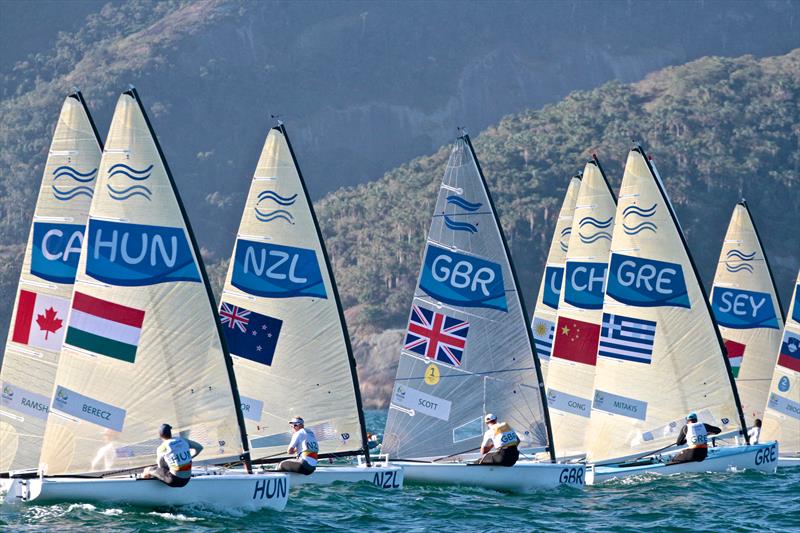
The Finn class is one of five "under review" by World Sailing - Rio Olympics, August 2016 © Richard Gladwell
Over the past 40 years, Olympic Yachting has gone through a series of storms followed by calms.
Next month's Mid-Year Meeting is set down to be held at the Chelsea Football Club, London. The four-day session looks set to rival a Southern Ocean storm accompanied by a rogue wave of Submissions.
There are 65 submissions mostly from European countries and the Baltic states, looking to institute substantial change in the Events and Classes of Paris 2024, to be sailed out of Marseille.
The so-called emerging countries of sailing have scant representation on the submission schedule published on Thursday. There were no submissions from Oceania.
Australia and New Zealand, two of the top countries in Olympic sailing also didn't make any input.
Those emerging countries that did respond generally opted for a more conservative approach favouring minimal change, clearly wanting to protect their investment in existing classes - such as the 470, Laser and RS:X which are in the World Sailing viewfinder. The other classes and their events have been exempted.
The International Fireball Association who went head to head with the 470 when the choice of two-handed dinghy was made back in November 1972, is the one of a few that opted for no change in Events or Equipment - passing up the opportunity in their submission to reverse the decision made 46 years ago.
The most extreme submission comes from several Kiteboard associations which seek to drop the Mens and Womens 470, the Finn and both RS:X, and substitute them with two new windsurfing classes, two kiteboard classes and a Mixed Offshore Event requiring 2, 4 or 6 crew.
The Review process was triggered by the International Olympic Committee issuing its Agenda 2020 strategy document, which essentially increased the 2020 Olympics by 15 events, reduced athlete numbers by 285 from Rio, doubled the number of mixed events from nine in 2016 to 18 in 2020, and sought a 50/50 gender balance in athletes and events (i.e. medals).
In an update, the IOC expected to reach a 48.8% gender balance according to a June 2017 estimate.
The biggest loser in terms of athlete reduction was Athletics which dropped 105 athletes. Basketball was the only sport to gain numbers (+64), Sailing dropped 30 athletes and was stated to be reaching gender balance in 2020. There was one new Sailing Event listed - being the Nacra 17 shifting from Mixed Multihull to Mixed Foiling Multihull.
The IOC seemed pleased with the Mixed Multihull concept. World Sailing now wish to increase the numbers of Mixed Events to at least two and up to four. Most sports, including Rowing another Olympic boat sport, have no Mixed events and aren't planning to do so.
The Mixed idea came from World Sailing, then ISAF's, last review process - the Olympic Commission - a six-man one-woman team, drawn from the ISAF Council and Committees. The Commission was formed in 2009 after it became obvious that the sport needed to take a good look at itself in the IOC mirror.
It did that by undertaking a deep analysis of the Sport - an independent process that is sadly lacking in the current exercise, which seems to be characterised by half-baked ideas and self-interest that triggered the Olympic Commission review in 2009-10.
Led by then Yachting Australia CEO, Phil Jones, the Olympic Commission produced an objective report with which few could disagree. Parts of it were implemented before the 2012 Olympics. Some was implemented in the 2016 Olympic cycle.
One of its cornerstones was the lack of a successful World Cup series. Eight years later, World Sailing has been unable to make the concept work despite annual fiddling with format and venue. In its latest iteration, the regatta is sailed only in northern hemisphere venues.
Another cornerstone was the poor participation and takeup of the sport in so-called emerging countries - which were everywhere except Europe. In Africa and Oceania, in particular, the small participation in Olympic Sailing by IOC member nations in those regions was unacceptable.
Of the 53 IOC members in Africa, just 15 were ISAF MNA's. Across the last four Olympics just three of those 53 IOC members participated in the Sailing Olympic events. Oceania had 17 IOC members, and just two of those members participated in the 2004 and 2008 Olympics. At the time administrators in Australia and New Zealand were resisting the very formation of a regional body to be a forum for Oceania Sailing.
Fuzzy guidance
When it releases a document like Agenda 2020. The IOC doesn't tell its Sports what Events it wants to see. It's up to the Sports to produce their best slate - within the numbers of athletes and medals allowed.
The Olympic Games owner is like a grumpy uncle sitting in the corner opening presents on Christmas Day. Muted delight at a pleasant surprise. A slight frown at one which shows little imagination, or is not an old favourite. You soon know when the Single Malt isn't to the expected level of perfection.
The International Yacht Racing Union was formed in 1904. That's eight years after Yachting was included in the program of the first ever Olympics, and four years after the first Sailing Olympics were actually contested on the Seine and Le Harve.
Yachting is one of the foundation Olympic sports, anointed by Baron de Coubertin himself. Sailing's chances of being dropped as an Olympic Sport are highly unlikely. But it can't sleepwalk from one Olympic cycle to the next.
The Olympics are about tradition, athleticism, participation and Olympism. They used to be at their core, still are. The fetish in Sailing to be more media-friendly, precisely gender equal, have more mixed events, shift to extreme sports is not pursued with such relish in other comparable sports, such as Rowing - where in 2020 they will achieve gender equality, have seven events each for men and women, will have no mixed rowing events, and will still retain a lightweight event, despite the IOC frowning on such events.
While it had many failings, one of Sailing's few saving graces unearthed by the Olympic Commission was that Sailing rated very well in the area of New Media. Able to sheet off media developments in the Volvo Ocean race and America's Cup, that situation can only have improved.
While the grumpy old uncle realises he has to change, so he can relate to his second and third generations of nieces and nephews, he's still well aware of what puts the food on the table - TV revenue. The largely unresolved problem with New Media is how to monetise it.
Regular turmoil
Historically Yachting has a tradition of turning itself inside out when it comes to choosing its Events and the Equipment - to use IOC-speak.
Over the years the agony and anguish have increased exponentially as administrators try to rationalise a process to confound that historically almost always evolves into the irrational.
In the good old days - maybe up to the late 70's or even early 80's - Yachting was run by the International Yacht Racing Union - or an international federation of national authorities of countries running yacht racing in their respective territories. In those days yachts had hulls, rudders, tillers or wheels, sails and spars. They were often built by the sailors themselves or bought from a builder - not out of a shop with a credit card.
The IYRU office was a very modest affair based in Knightsbridge, London, with a handful of paid administrative staff - Richard Hollis, Nigel Hacking with Tony Watts on Measurement aided by numerous Brits like Gerald Sambrooke-Sturgess and Mary Pera on the rules side. They were the quintessential administrators well practised in the art of steering quietly from the rear, with good humour and without rancour, rather than leading noisily from the front.
The decisions were made by elected delegates on the ISAF Council, the sport's traditional governing body. Most knew each other from their competitive sailing days. They all had real jobs from all walks of life.
Many had been sailing Olympians. There was a camaraderie that enabled differences to be discussed and settled in the way they always were - at a function or over a quiet drink, remembering what they had in common and worked - rather than their current point of difference.
The IYRU Committees were drawn from the ranks of the Class Associations and elsewhere in the sport. Some were in the marine industry. All were required to be - and seen to work independently and for the benefit of the sport, not the class in which they were involved. Now some of those positions previously occupied by volunteers, are being taken over by paid professionals employed by the classes, or national authorities. In the eyes of many those appointments have a conflict of interest since they cannot vote against the interests of their employer.
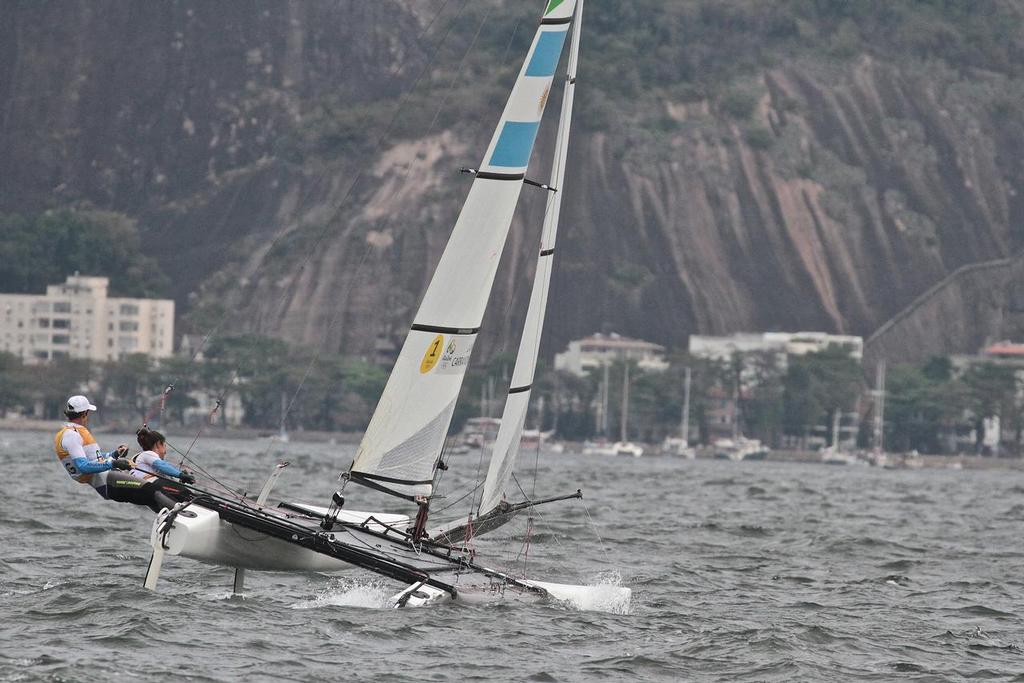 www.photosport.co.nz"
www.photosport.co.nz" />
Santiago Lange and Cecilla Saroli head upwind for the second time in the Nacra 17 Medal race. After winning the Gold Medal, Lange let fly with some advice for World Sailing on plans to upgrade the Nacra 17 to a full foiler - photo © Richard Gladwell
www.photosport.co.nz
In the days of the IYRU, Olympic classes often came about through selection trial - as in the case of the Finn, and more recently the 49ers. The 470 was a well-established class before it became Olympic. The Tempest, Soling, Flying Dutchman, Tornado came out of that process.
The Laser became an Olympic class because of its obvious popularity. The Olympics needed the Laser rather than the other way around.
All were run on the same collegial basis of a class owners association, usually with some of the top sailors in the class running the national and world associations.
The London based members of these world bodies could saunter over to the IYRU offices in Knightsbridge, sort out the issue over a cup of tea and go back to their office.
In the early 80's the IYRU became more professional, in that more of its functions were undertaken by an increasing number of paid staff.
The Olympic classes that were part of the five-ring circus at that time were structured as class associations, run by the sailors, with design rights handed over to the IYRU who in turn licenced and controlled the builders, and covered their costs with a modest building plaque fee - a slice of which formed part of the very modest designer royalties.
Three of the current Olympic classes (Equipment) - the Finn and 470 hail from that era and forty years later find themselves "Under Review" at next month's Mid-Year Meeting of the then IYRU, now World Sailing.
In the past 40 years, the basis of class administration has shifted from sailor-run class associations, where boats in the class are constructed by licenced builders under the IYRU auspices. Many of those started out as sailors in their chosen class, thought they could build a better boat, and did a few for themselves and their friends. Because they had the time, ability and interest they usually did a very good job and then were able to turn it into a successful commercial venture.
Same with sailmakers - Paul Elvstrom, Lowell North, Keith Musto, Dave Ullman - to name but a few all started major sailmaking outfits off the back of making sails for the Olympic classes in which they sailed. Now only two of the seven Olympic classes are able to use sails and spars that are not supplied by a single manufacturer. There is more scope on the boat building side with the Finn and 470 being built on the true licenced builder system (both under Review by World Sailing) and the 49er and 49erFX have a limited number of licenced builders.
The point being with sailmaking in particular that the shift into single suppliers has a big downstream effect on the marine industry, development of new companies, and the leadership of those companies by people who are also top competitors in the sport.
Now the newer classes are products, often sold in shops by commercial outfits, with shareholders, patents and all the legal "fun" that goes with that particular fair.
By their very commercial model, the latter can well afford the bevvy of lawyers, marketing people and aggressive lobbyists that can make incredibly compelling arguments and slideshows, ostensibly aimed at the advancement of the sport, but coincidentally enhancing the commercial advancement of their master's product.
But like all products, they have a life cycle. Even more significantly their companies, patents and commercial paraphernalia can be bought and sold. Their sailors can but watch and hope - largely powerless to intervene or influence.
Windsurfing runaround
Sitting between the old world and the new is the Windsurfer - which is now on the "naughty list" and slated for review as an Event, Equipment and for EU anti-trust regulation compliance.
Back in November 1980, under benevolent nudging from the IOC, the IYRU was encouraged to embrace the new sport of windsurfing.
There were various contenders - the Windsurfer which had begun the sport designed by Hoyle Schweitzer (Calif. USA), was owned by a commercial organisation and covered by patents. ISAF found that level of commercialism too hard to swallow.
The other choice was the German developed Windglider, which its owners offered to the IYRU on the world federation's established building plaque/design ownership model. Ironically German option got the IYRU's nod for an Olympics to be held to be held in Southern California, the birthplace of the Windsurfer.
Of course, the IYRU couldn't call its new sport "Windsurfing" because of potential trademark infringement and coined the term "Boardsailing". That triggered a period of constant change with the IYRU/ISAF opting for four different board sailing classes in four successive Olympics, before opting for a more commercial model with the Mistral (1996-2004) and the fifth, another commercial model the RS:X being used in Qingdao, Weymouth and Rio Olympics.
That Event (now eventually called "Windsurfing) and the Equipment (RS:X) are the fourth and fifth events up for review in the process which takes a further step next month.
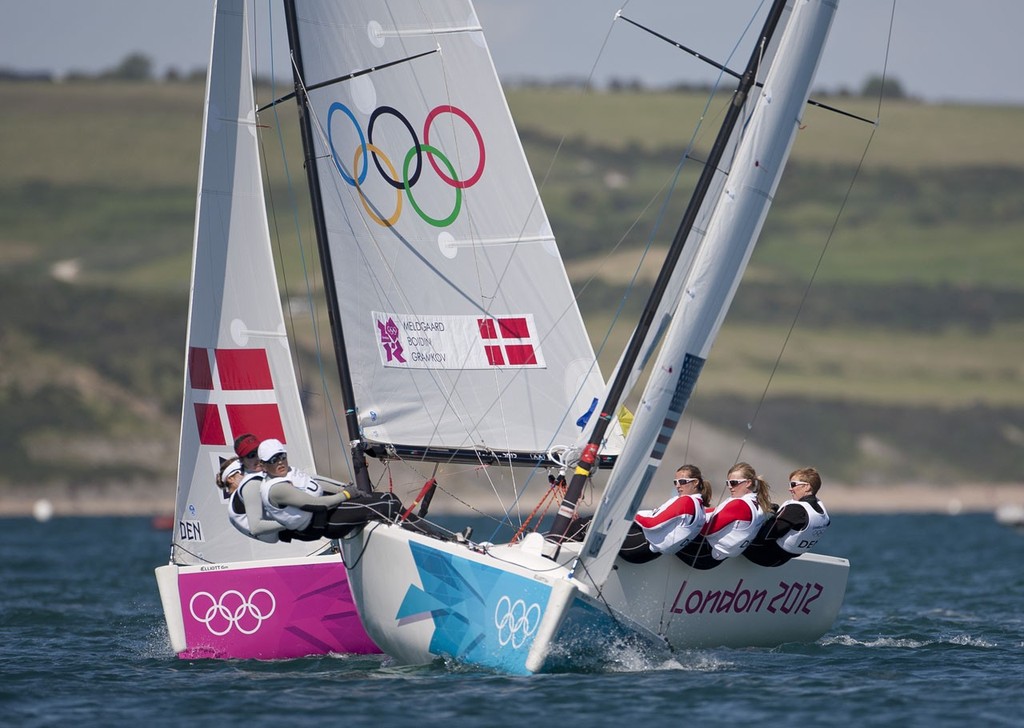 www.onEdition.com"
www.onEdition.com" />
The Women’s Match Racing (Elliott 6M) event in the 2012 Olympic Sailing Regatta was an expensive one-off excursion by ISAF in the search for a media friendly event. - photo © onEdition
www.onEdition.com
The sidebar to the Review process of the Five Events and Equipment is a parallel Review of the commercial arrangements in place in case the class building arrangements contravene European Union Anti-Trust Regulations.
World Sailing has selected the four items of Equipment or Classes for the anti-trust review - the RS:X and the Laser - covering four events. Both have two forms in the Olympics with a common hull/board and associated components, along with separate rigs for the men's and women's events.
With its Euro-centric view of yachting, World Sailing seems to be oblivious to the fact that other member territories are not part of the European Union, are not subject to its regulations, have different Anti-Trust (or monopoly/consumer protection law) and might just be fine, thank you very much.
The two reviews are described in an eight page, 25 question so-called "Frequently Asked Questions" - a PR euphemism for putting the "right" spin on a complex and fraught situation.
Midway through the World Sailing FAQ lies the eye of a potential storm.
12) What happens if an Event is under review?
If an Event is under review, then World Sailing can then proceed to make one of the
following four decisions:
• Retain Event and retain Equipment
• Retain Event and evolve Equipment
• Retain Event and select new Equipment
• Select new Event and select new Equipment
At World Sailing the contemporary governance model seems to be that when faced with a complex decision process, the procedure is to take policy guidance from committees of various types; have a decision on the preferred policy determined by the Council, and then have that preferred policy expressed in Regulations.
Then the Regulations are applied to the situations and circumstances, and the sailing world has to digest the output from this sausage-machine.
The bureaucrats' PR spin is that the decision has been arrived at consistent with World Sailing's policies and regulations.
One only has to watch a couple of episodes of "Yes Minister" to realise how this process really works and can be manipulated by the politicians, lobbyists and lawyers to obtain the outcome desired by their masters.
The by-product from the sausage machine is one of unintended consequences.
Looking at the decision matrix above, in three of the four scenarios, there is the option to change the event or class. This is separate from the Olympic Class and Equipment review.
Curiously in its outcomes above, World Sailing believes it can somehow "evolve" the "Equipment". Hopefully not with the amount of collateral damage that has resulted from its "evolution" of the Multihull at the Olympics.
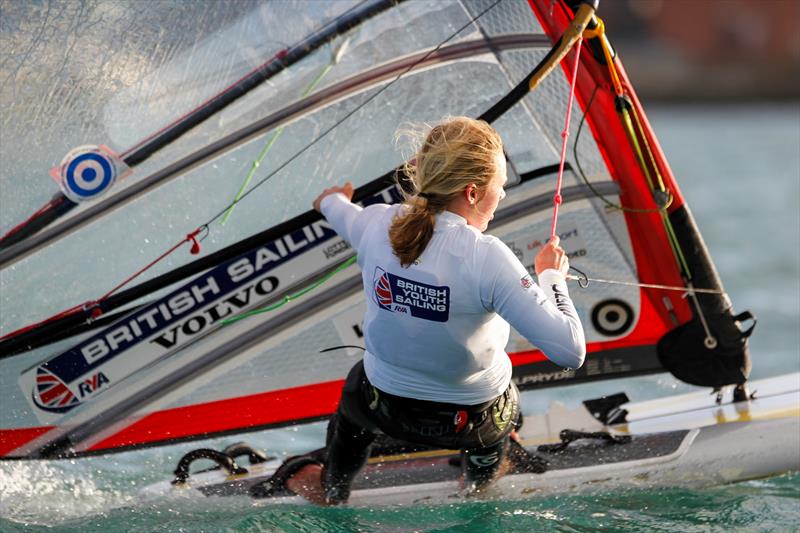 www.pwpictures.com"
www.pwpictures.com" />
Emma Wilson, RS:X, GBR 7 - the Laser, Laser Radial and RS:X M&W have a progression from the Youth classes, and availability of second hand gear works for the emerging nations - photo © Paul Wyeth /
www.pwpictures.com
Gold Medalist's lecture
To refresh their memories of how badly they have done in the past, the World Sailing Council and others involved should heed the experiences of Multihull sailors at the Olympic level - expressed at a media conference at the 2016 Olympics in Rio by Gold medalist Santiago Lange.
The Argentinian made an impassioned plea for caution to the class-fiddlers who had signalled their intention to upgrade the Nacra 17 catamaran to be a full foiler.
Lange, a veteran of six Olympics sailed his fourth Olympic regatta in the Mixed Multihull class at Rio. He had been burned by design changes made the then International Sailing Federation in moves to add spectacle to the Sailing Olympics while adopting a policy of minimal change elsewhere.
“My story goes as follows,” Lange began. “I campaigned the Tornado for 2000 and had to change the whole boat with a spinnaker/gennaker and other reconfigurations. That was expensive. Then for the Olympics in Athens, they changed to a carbon mast – that was expensive again.
“Then I heard that World Sailing was going to keep the core classes the same for 2020 – I thought this was the best statement from World Sailing, as we need a steady sport. Now that too has changed.
“World Sailing has a responsibility to have a good vision for the future, whether they consult with designers or athletes or whoever, they have to be able to see 20 or 30 years out."
“Now we invest a lot of money in these Nacra 17's. We have four boats. We have 15 mainsails. Some mainsails we only use for one hour. We have four spinnakers with the flag, a couple of them we only use for a couple of hours."
He skipped over the fact that the Multihull and Tornado was dropped as an event/class for the 2012 Olympics in favour of the short-lived Women's Match Racing event in the Elliott 6's. That was another expensive ISAF mis-fire.
The Multihull came straight back in after shift to foiling multihulls in the America's Cup. Instead of adopting one of the many catamaran classes in existence, World Sailing opted for a new class - made it a partial foiler - and in a me-too moment and despite Lange's comments fiddled with it yet again in November 2016 to get it to a full foiler.
The multihull situation is not unique. Of course, there are the previously mentioned four different board sailing classes in four successive Olympics. The Matchracing "media friendly" event and others.
Undeterred by its past "whoopsies" World Sailing has opted to wave its blowtorch over half of the Olympic classes embracing the RS:X, the 470 and the Finn, covering the men's and women's windsurfing (RS:X), the men's and women's two-person dinghy (470), and the men's one person heavyweight dinghy (Finn)
The RS:X can also get caught out under a second pass in the Anti-Trust inquest along with the Laser in its hull and rig forms (standard and radial).
Small wonder that the vultures of the sailing board sports world smell blood from the RS:X blood and are circling.
Because the 470 and Finn are the oldest classes, and for the reasons previously outlined historically locked into a sailor driven, non-commercial, class association, licenced builder model, they too are very vulnerable to the commercially driven replacement products - particularly new offerings from existing companies who can trim the components of their models to suit the vagaries of the World Sailing and Olympic selection breeze.
In Part 2, we'll look at the Class options.
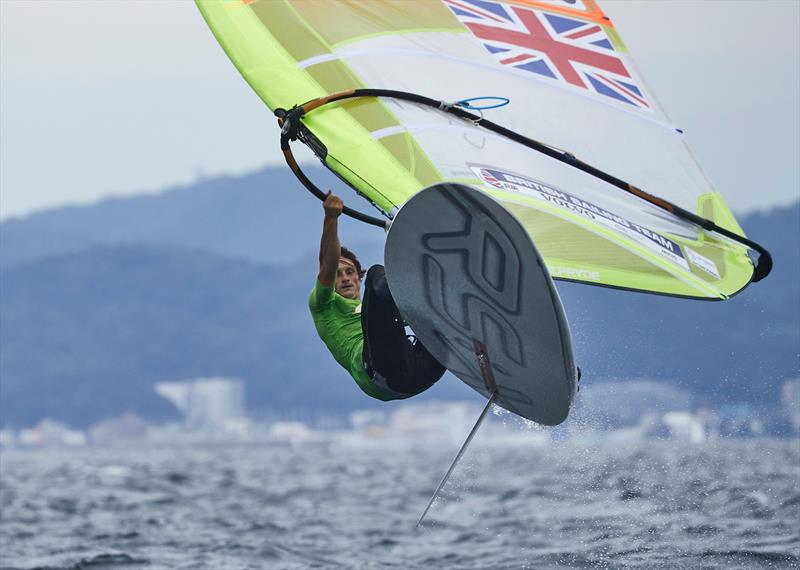 www.Shuttersail.com"
www.Shuttersail.com" />
Kieran Martin during the 2017 RS:X Worlds at Enoshima, Japan - the current Olympic classes will remain unchanged for Tokyo 2020 - photo © Robert Hajduk /
www.Shuttersail.com